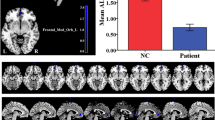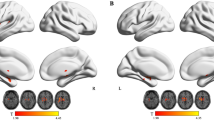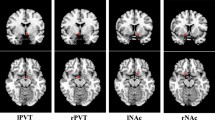Abstract
Nocturnal enuresis (NE) is a common disorder in school-aged children that has been reported to affect nearly 10% of 7-year-old children and affects both the children and their families. Previous studies have shown that the risk of psychosocial difficulties in children with enuresis is elevated. Thus, children with NE may experience negative effects on psychosocial health or emotion processing. Therefore, the aim of this study was to investigate the potential disturbance in emotional processing in children with NE using functional magnetic resonance imaging (fMRI). In this work, we used fMRI and an affective picture task to evaluate brain response changes in children with NE. Two groups, one consisting of 22 children with primary monosymptomatic NE and one with 23 healthy controls, were scanned using fMRI. Compared to the healthy subjects, children with NE mainly showed increased activation when viewing negative vs. neutral pictures in the bilateral medial superior frontal gyrus that extended to the anterior cingulate cortex. Our results demonstrated that children with primary monosymptomatic NE showed abnormal neural responses to emotional stimuli and overactivation in the medial prefrontal and anterior cingulate cortices suggested that children with primary monosymptomatic NE may be hypersensitive in their sensory perception of negative pictures.


Similar content being viewed by others
References
Aldhafeeri FM, Mackenzie I, Kay T, Alghamdi J, Sluming V (2012) Regional brain responses to pleasant and unpleasant IAPS pictures: different networks. Neurosci Lett 512:94–98
Austin PF, Bauer SB, Bower W, Chase J, Franco I, Hoebeke P, Rittig S, Walle JV, von Gontard A, Wright A, Yang SS, Neveus T (2016) The standardization of terminology of lower urinary tract function in children and adolescents: update report from the standardization committee of the International Children’s Continence Society. Neurourol Urodyn 35:471–481
Bai L, Ma H, Huang Y, Luo J (2005) The development of native chinese affective picture system—a pretest in 46 college students. Chin Ment Health J 19:719–722
Bechara A, Damasio H, Damasio AR (2000) Emotion, decision making and the orbitofrontal cortex. Cereb Cortex 10:295–307
Blok BF, Willemsen AT, Holstege G (1997) A PET study on brain control of micturition in humans. Brain 120(Pt 1):111–121
Bower WF, Sit FK, Bluyssen N, Wong EM, Yeung CK (2006) PinQ: a valid, reliable and reproducible quality-of-life measure in children with bladder dysfunction. J Pediatr Urol 2:185–189
Burkhouse KL, Kujawa A, Hosseini B, Klumpp H, Fitzgerald KD, Langenecker SA, Monk CS, Phan KL (2018) Anterior cingulate activation to implicit threat before and after treatment for pediatric anxiety disorders. Prog Neuropsychopharmacol Biol Psychiatry 84:250–256
Carey MP, Gresham FM, Ruggiero L, Faulstich ME, Enyart P (1992) Children’s depression inventory. J Consult Clin Psychol 55(5):755–761
Carlson JM, Depetro E, Maxwell J, Harmon-Jones E, Hajcak G (2015) Gender moderates the association between dorsal medial prefrontal cortex volume and depressive symptoms in a subclinical sample. Psychiatry Res 233:285–288
Equit M, Becker A, El Khatib D, Rubly M, Becker N, von Gontard A (2014) Central nervous system processing of emotions in children with nocturnal enuresis and attention-deficit/hyperactivity disorder. Acta Paediatr 103:868–878
Etkin A, Egner T, Kalisch R (2011) Emotional processing in anterior cingulate and medial prefrontal cortex. Trends Cogn Sci 15:85–93
Evans KC, Simon NM, Dougherty DD, Hoge EA, Worthington JJ, Chow C, Kaufman RE, Gold AL, Fischman AJ, Pollack MH, Rauch SL (2009) A PET study of tiagabine treatment implicates ventral medial prefrontal cortex in generalized social anxiety disorder. Neuropsychopharmacology 34:390–398
Fowler CJ, Griffiths DJ (2010) A decade of functional brain imaging applied to bladder control. Neurourol Urodyn 29:49–55
Griffiths D, Tadic SD (2008) Bladder control, urgency, and urge incontinence: evidence from functional brain imaging. Neurourol Urodyn 27:466–474
Gulisano M, Domini C, Capelli M, Pellico A, Rizzo R (2017) Importance of neuropsychiatric evaluation in children with primary monosymptomatic enuresis. J Pediatr Urol 13:36e31–36e36
Kavia RB, Dasgupta R, Fowler CJ (2005) Functional imaging and the central control of the bladder. J Comp Neurol 493:27–32
Kessel EM, Allmann AE, Goldstein BL, Finsaas M, Dougherty LR, Bufferd SJ, Carlson GA, Klein DN (2017) Predictors and outcomes of childhood primary enuresis. J Am Acad Child Adolesc Psychiatry 56:250–257
la Greca AM, Dandes SK, Wick P, Shaw K, Stone WL (1988) Development of the Social Anxiety Scale for Children: reliability and concurrent validity. J Clin Child Psychol 17:84–91
Lei D, Ma J, Du X, Shen G, Tian M, Li G (2012) Altered brain activation during response inhibition in children with primary nocturnal enuresis: an fMRI study. Hum Brain Mapp 33:2913–2919
Lei D, Ma J, Du X, Shen G, Tian M, Li G (2012) Spontaneous brain activity changes in children with primary monosymptomatic nocturnal enuresis: a resting-state fMRI study. Neurourol Urodyn 31:99–104
Lei D, Ma J, Shen X, Du X, Shen G, Liu W, Yan X, Li G (2012) Changes in the brain microstructure of children with primary monosymptomatic nocturnal enuresis: a diffusion tensor imaging study. PLoS ONE 7:e31023
Marciano RC, Cardoso MGF, Vasconcelos MA, Paula JJ, Pinho NC, Oliveira AC, Oliveira EA, Lima EM (2018) Behavioral disorders and impairment of quality of life in children and adolescents with lower urinary tract dysfunction. J Pediatr Urol. https://doi.org/10.1016/j.jpurol.2018.07.017
Neveus T, von Gontard A, Hoebeke P, Hjalmas K, Bauer S, Bower W, Jorgensen TM, Rittig S, Walle JV, Yeung CK, Djurhuus JC (2006) The standardization of terminology of lower urinary tract function in children and adolescents: report from the Standardisation Committee of the International Children’s Continence Society. J Urol 176:314–324
Phan KL, Wager T, Taylor SF, Liberzon I (2002) Functional neuroanatomy of emotion: a meta-analysis of emotion activation studies in PET and fMRI. NeuroImage 16:331–348
Qiao Y, Xie B, Du X (2012) Abnormal response to emotional stimulus in male adolescents with violent behavior in China. Eur Child Adolesc Psychiatry 21:193–198
Riccabona M (2010) Evaluation and management of enuresis. An update. Urologe A 49:861–869 (quiz 870)
Salehi B, Yousefichaijan P, Rafeei M, Mostajeran M (2016) The relationship between child anxiety related disorders and primary nocturnal enuresis. Iran J Psychiatry Behav Sci 10:e4462
Sarici H, Telli O, Ozgur BC, Demirbas A, Ozgur S, Karagoz MA (2016) Prevalence of nocturnal enuresis and its influence on quality of life in school-aged children. J Pediatr Urol 12(159):e151–156
Saunders B, Lin H, Milyavskaya M, Inzlicht M (2017) The emotive nature of conflict monitoring in the medial prefrontal cortex. Int J Psychophysiol 119:31–40
Savaser S, Kizilkaya Beji N, Aslan E, Gozen D (2018) The prevalence of diurnal urinary incontinence and enuresis and quality of life: sample of school. Urol J 15:173–179
Spencer-Smith M, Anderson V (2009) Healthy and abnormal development of the prefrontal cortex. Dev Neurorehabilit 12:279–297
Theunis M, Van Hoecke E, Paesbrugge S, Hoebeke P, Vande Walle J (2002) Self-image and performance in children with nocturnal enuresis. Eur Urol 41:660–667 (discussion 667)
Tsujimoto S (2008) The prefrontal cortex: functional neural development during early childhood. Neuroscientist 14:345–358
Ucer O, Gumus B (2014) Quantifying subjective assessment of sleep quality, quality of life and depressed mood in children with enuresis. World J Urol 32:239–243
von Gontard A, Niemczyk J, Weber M, Equit M (2015) Specific behavioral comorbidity in a large sample of children with functional incontinence: report of 1,001 cases. Neurourol Urodyn 34:763–768
Wang M, Su J, Zhang J, Zhao Y, Yao Q, Zhang Q, Zhang H, Wang S, Li GF, Liu JR, Du X (2017) Visual cortex and cerebellum hyperactivation during negative emotion picture stimuli in migraine patients. Sci Rep 7:41919
Wang M, Zhang K, Zhang J, Dong G, Zhang H, Du X (2015) Abnormal neural responses to emotional stimuli but not Go/NoGo and Stroop tasks in adults with a history of childhood nocturnal enuresis. PLoS ONE 10:e0142957
Wellman CL, Moench KM (2018) Preclinical studies of stress, extinction, and prefrontal cortex: intriguing leads and pressing questions. Psychopharmacology. https://doi.org/10.1007/s00213-018-5023-4
Wilber AA, Walker AG, Southwood CJ, Farrell MR, Lin GL, Rebec GV, Wellman CL (2011) Chronic stress alters neural activity in medial prefrontal cortex during retrieval of extinction. Neuroscience 174:115–131
Wu M, Kujawa A, Lu LH, Fitzgerald DA, Klumpp H, Fitzgerald KD, Monk CS, Phan KL (2016) Age-related changes in amygdala-frontal connectivity during emotional face processing from childhood into young adulthood. Hum Brain Mapp 37:1684–1695
Zhang J, Lei D, Ma J, Wang M, Shen G, Wang H, Yang G, Du X (2014) Brain metabolite alterations in children with primary nocturnal enuresis using proton magnetic resonance spectroscopy. Neurochem Res 39:1355–1362
Zink S, Freitag CM, von Gontard A (2008) Behavioral comorbidity differs in subtypes of enuresis and urinary incontinence. J Urol 179:295–298 (discussion 298)
Acknowledgements
This research was supported by grants from the National Natural Science Foundation of China (Grant number 81571658) and the Social Science Foundation of China (Grant number 15ZDB016).
Author information
Authors and Affiliations
Corresponding authors
Ethics declarations
Conflict of interest
On behalf of all authors, the corresponding author states that there is no conflict of interest.
Rights and permissions
About this article
Cite this article
Wang, M., Zhang, A., Qin, Z. et al. Abnormal neural responses to emotional stimuli in children with primary monosymptomatic nocturnal enuresis. Eur Child Adolesc Psychiatry 28, 949–956 (2019). https://doi.org/10.1007/s00787-018-1255-4
Received:
Accepted:
Published:
Issue Date:
DOI: https://doi.org/10.1007/s00787-018-1255-4




